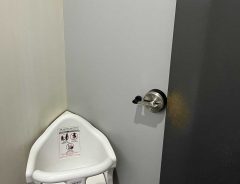- Tags:
- Bathroom / hygiene / squat toilet / Toilet
Related Article
-

Japanese rest stop’s restroom setup has parents clamoring for it to be set up everywhere
-

Woman sees “darkness” of Japanese society in convenience store bathroom; “I’m at a loss for words”
-

All It Takes Is 13 Seconds For This Little Kitten To Do Something Totally Unexpected!
-

Pictograms at a Japanese restroom look like a horror film poster
-

Young boy has a surprising reaction when asked if he’s been to the bathroom [manga]
-

“D for Dandy?” Japanese man confused by sign on Dutch bathroom door



It’s happened so many times.
I have a busy day and a jam-packed schedule with obligations that take me from one side of the city to the other. I rush down the street and into a client’s office. As soon I get there, it's already time to go--the next train is in ten minutes. The train doors close behind me as I push my way on, and in about five stops, I scurry to transfer to the subway.
I have to get back to the downtown area before 3 o'clock. If I timed things correctly, I'll have time for a ten-minute, super-late lunch and an energy drink. What!? Wait, the train stopped. Why aren’t we moving!? Before I even arrive, my break is gone, and I'm still stuck in a packed subway car. Now nature's calling, and I gotta accept the call. The train doors finally open, and I rush to the bathroom before I run across the street to my next client’s office.
Sweating, I swing open the door to the lavatory, and gasp: the sight is unspeakable. Like some septic, nightmarish scene from a 1980s horror movie. The aftermath of The Swamp Thing. Dear God! the chaos...the splatter….the smell...and the horror! I panic and cry out. But no one can hear me scream.
If you Sprinkle When You Tinkle, Be a Sweetie, Wipe the Seatie
I shouldn't put too fine a point on it. If you’ve been to Japan, or are familiar with the culture, then you know how clean this country can be. Restaurants and residents’ homes are often spotless, while city streets are clutter-free. Waste is painfully sorted, and everyone has a role to play. School children clean their school rooms, and signs remind customers to keep facilities spotless. Even public restrooms are usually clean.
Emphasis on usually.
Nevertheless, we all have room for improvement, and municipalities are no different. Nationwide, cities are working on sprucing up public toilets in a bid to support the tourism sector as well as encourage use by local residents.
Japan Tackles Unkempt Toilets
According to The Japan Times, Japan is undergoing a nationwide initiative to improve the condition of its public restrooms. Of particular interest are countless park restrooms. Pit toilets and flush toilets are intermixed in parks throughout the country, but without maintenance, they can become unsightly and foul-smelling.
The initiative is entirely pertinent believes Kohei Yamamoto, a representative of the Japan Toilet Association. “The lack of hygiene in public toilets can discourage people across all generations from going out, and potentially have an adverse effect on tourists’ perception of areas they visit,” Yamamoto told The Japan Times.
Residents across Japan agree. Take the southern city of Iwakuni, for example. Grossed-out residents are putting increased pressure on city officials to improve the sanitary conditions of park facilities. A 40-year-old Iwakuni housewife commented on a nearby park, “the restroom is dimly lit and the pit toilets inside are filthy. My [3-year-old] daughter is scared to go inside and she won’t use it even if she needs to relieve herself.” Many other parents and daycare workers face similar issues.
The mayor of Nagoya, Takashi Kawamura, is definitely onboard with the initiative. In anticipation of a blitz of foreign tourist during the now-postponed 2020 Olympics, Nagoya began an aggressive public facilities campaign back in 2017 to make the city’s toilets “the coolest in the world.”
If you’re unaware, Japan traditionally uses squat toilets, although Western toilets are common in recent years. Here’s a whimsical overview for your viewing pleasure.
Needless to say, some people struggle.
Nevertheless, the effort is nothing to sneeze at. According to the Nagoya government, approximately 1,500 public toilets at sightseeing spots and other common destinations were Japanese-style squats toilets prior to the policy move. The municipal government plans to spend 1 to 2 billion JPY (9.33 to 18.66 million USD) on the renovations and will also change restroom flooring in order to limit odors.
LDP member Takao Saito summarized the reasoning behind the plan: “If Nagoya wants to become a major tourist destination, isn’t it necessary to provide first-class hospitality?” Apparently, an increasing number of residents in Nagoya and throughout Japan agree as they appear more than willing to allocate public funds.
Such “political will” is likely entirely necessary. The burden public facility renovations impose on local governments is far from trivial. According to an effected city official, "Each renovation costs about ¥10 million to ¥20 million ($93,000 - $186,000).” With such considerable costs, other cities are working with private entities to limit the tax-payer burden. Okayama city, for example, gives naming rights to corporations that cover the cost of renovating lavatories. The companies in-turn hire sanitation workers to maintain clean facilities.
Once the COVID-19 pandemic lifts, hopefully, these improvements will pay dividends as tourism returns to normal. Even if that takes time, children and adults alike can look forward to more recreation time at parks without holding their nose should they need the restroom.